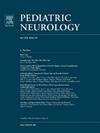皮质回旋与结节性硬化症复合体的临床表型有关。
IF 3.2
3区 医学
Q2 CLINICAL NEUROLOGY
引用次数: 0
摘要
背景:结节性硬化综合征(TSC)的特点是皮质管状结构,决定了皮质的错乱,进而导致耐药性癫痫、智力障碍和TSC相关神经精神障碍(TAND):研究目的:确定回旋指数(GI)这一基于软件的神经放射学参数是否与TSC表型的严重程度相关,从而确定与主要临床表现的严重程度更相关的皮质区域:这是一项回顾性横断面研究。磁共振成像由 1.5-T 扫描仪采集。CAT12 工具箱用于估算 GI。使用 Jamovi 进行数据分析。显著性水平设定为 P 结果:共纳入 45 名 TSC 患者和 42 名健康对照者。与健康对照组相比,TSC 患者的总消化道指数较高(P = 0.002)。在 TSC 患者中,较高的总 GI 与神经系统检查受损(P = 0.039)、癫痫(P = 0.017)、智力障碍(P = 0.013)、TAND(P = 0.013)和较多的皮质管数量(P 结论:总 GI 是一种基于软件的神经网络成像技术:GI是一种基于软件的神经放射学参数,可作为TSC可靠的总体预后标志。局部 GI 可用于识别表型特异性回旋模式,从而对 TSC 患者进行早期定性。本文章由计算机程序翻译,如有差异,请以英文原文为准。
Cortical Gyrification Is Associated With the Clinical Phenotype in Tuberous Sclerosis Complex
Background
Tuberous sclerosis complex (TSC) is characterized by cortical tubers, determining cortical disarrangement and consequently drug-resistant epilepsy, intellectual disability, and TSC-associated neuropsychiatric disorders (TAND).
Aim of the study
To establish whether gyrification index (GI), a software-based neuroradiological parameter, could be associated with the severity of phenotype in TSC, identifying the cortical regions that are more associated with the severity of the main clinical manifestations.
Methods
This was a retrospective cross-sectional study. Magnetic resonance imaging was acquired on a 1.5-T scanner. CAT12 toolbox was used for the estimation of GI. Data analysis was performed with Jamovi. The level of significance was set to P < 0.05 for all tests.
Results
Forty-five patients with TSC and 42 healthy controls were included. Patients with TSC were characterized by higher total GI (P = 0.002) compared with healthy controls. Among patients with TSC, a higher total GI was associated with impaired neurological examination (P = 0.039), epilepsy (P = 0.017), intellectual disability (P = 0.013), TAND (P = 0.013), and higher number of cortical tubers (P < 0.001). An increased local GI in specific cortical areas was associated with TAND and autism spectrum disorders.
Conclusions
GI is a software-based neuroradiological parameter that could represent a reliable overall prognostic marker in TSC. Local GI can be used to identify phenotype-specific gyrification patterns allowing an early characterization of patients with TSC.
求助全文
通过发布文献求助,成功后即可免费获取论文全文。
去求助
来源期刊

Pediatric neurology
医学-临床神经学
CiteScore
4.80
自引率
2.60%
发文量
176
审稿时长
78 days
期刊介绍:
Pediatric Neurology publishes timely peer-reviewed clinical and research articles covering all aspects of the developing nervous system.
Pediatric Neurology features up-to-the-minute publication of the latest advances in the diagnosis, management, and treatment of pediatric neurologic disorders. The journal''s editor, E. Steve Roach, in conjunction with the team of Associate Editors, heads an internationally recognized editorial board, ensuring the most authoritative and extensive coverage of the field. Among the topics covered are: epilepsy, mitochondrial diseases, congenital malformations, chromosomopathies, peripheral neuropathies, perinatal and childhood stroke, cerebral palsy, as well as other diseases affecting the developing nervous system.
 求助内容:
求助内容: 应助结果提醒方式:
应助结果提醒方式:


